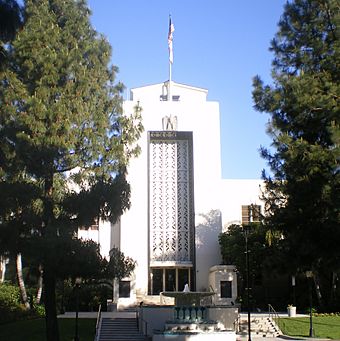Burbank City Hall facts for kids
Quick facts for kids |
|
|
City Hall–City of Burbank
|
|

Burbank City Hall
|
|
| Location | 275 E. Olive Ave., Burbank, California |
|---|---|
| Built | 1943 |
| Architect | William Allen and W. George Lutzi |
| Architectural style | Moderne |
| NRHP reference No. | 96000426 |
| Added to NRHP | April 18, 1996 |
Burbank City Hall is a really important building in Burbank, California. It's where the city's government works, making decisions for everyone who lives there. This special building is also listed on the National Register of Historic Places, which means it's recognized as an important historical site in the United States.
Contents
Welcome to Burbank City Hall!
The City Hall was designed by architects William Allen and W. George Lutzi. They created it in a cool style called Moderne. Building started in February 1941 and finished in 1943. The project got some money from the Federal Works Agency and the Works Progress Administration (WPA). The total cost was about $409,000.
In 1996, Burbank City Councilman Ted McConkey said the building was unique. He mentioned its special design and how well it was kept. He also talked about the amazing murals inside. Many film companies even ask to use City Hall for their movies! When it was added to the National Register of Historic Places in 1996, it was only the second building in Burbank to get this honor. The first was Burbank's main post office.
A Look Inside
The building has a tall tower that is 77 feet high. This tower acts as the main entrance lobby. Inside, you'll see cool Art Deco designs. More than 20 types of marble were used! You can spot marble in the city seal on the floor, the wall trim, and even on the stairs.
The City Hall also features many artistic works. There are cast medallions and a bas-relief sculpture by Bartolo Mako. This sculpture is called "A Tribute to Craftsmen" and is on the Third Street side. You can also see two other bas-relief panels on the front of the building. Plus, there's a framed painting called "Justice," also by Mako.
Amazing Art: The Murals
The most famous art at Burbank City Hall are the huge murals painted by Hugo Ballin. Ballin also painted murals at the Griffith Observatory and Wilshire Boulevard Temple. There are two main Ballin murals at Burbank City Hall. They are "The Four Freedoms" in the Council Chamber and "Burbank Industry" in the rotunda. In 2001, the building was updated, and the Ballin murals were carefully cleaned and fixed.
"The Four Freedoms" Mural
The Council Chamber is on the second floor. It has walls made of teakwood. This is where you'll find Ballin's "Four Freedoms" mural. This mural was inspired by Franklin Roosevelt's 1941 "Four Freedoms" speech. Many people think it's one of Ballin's best works. The chamber used to have carved wooden benches. In 1978, these were changed to comfy theater-style seats. The floor was also covered with carpet. During the 2001 updates, the ceiling was made taller again. This showed the top part of the "Four Freedoms" mural, which had been hidden for many years.
"Burbank Industry" Mural
The "Burbank Industry" mural is in the rotunda. It shows things that were important to Burbank's growth. You can see airplanes built in Burbank, the motion picture industry, farming, and a power plant. In 1964, the bottom part of this mural was removed. This was done to make space for a bridge to another city building.
The removed part of the mural was stored away for 37 years. It was kept in different places, like under a street bridge and in a museum. Later, the 1964 building and its bridge were taken down. The lower section of the mural was then brought back and put in its original place. Art experts carefully reattached it. A special ceremony to show all the restored art happened on September 10, 2001.




